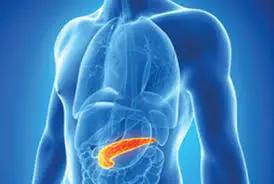Chronic pancreatitis is a challenging condition and being aware of what happens if it is not treated is important for treatment adherence, long-term health and quality of life. Long-term pancreas inflammation impacts daily life, causing persistent chronic pain and digestive system issues. If these symptoms are not treated, complications such as diabetes, pancreatic cancer, and pseudocysts (fluid sacs) can develop. Let’s explore the long-term effects of untreated chronic pancreatitis, including the signs and symptoms of chronic pancreatitis.
Is it possible to live without a pancreas?
The simple answer is no. The pancreas is a small, pear-shaped organ that sits behind the stomach and has two important functions in the body:
- Produces enzymes that help digest food
- Producing hormones that help regulate blood sugar levels
The two main cell types of the pancreas are exocrine and endocrine cells. Exocrine cells form most of the pancreas and produce enzymes released into the small intestine to help break down food. When these cells become inflamed or disrupted pancreatitis can occur suddenly (acute pancreatitis). Repeated episodes of acute pancreatitis lead to chronic pancreatitis.
Symptoms of chronic pancreatitis
Inflammation of the pancreas brings on a range of symptoms
- Abdominal pain
- Bloating
- Weight loss
- Nausea
- Vomiting
- Diarrhoea
Gastrointestinal symptoms are dominant in chronic pancreatitis. A telltale sign is steatorrhea which is large volumes of loose, pale, and foul-smelling stools that are difficult to flush. The damaged pancreas struggles to produce enough digestive enzymes, leading to poor fat absorption. As the damage to the pancreas progresses complications can occur due to deteriorating pancreatic function.
Complications of chronic pancreatitis
Diabetes
Type 3C diabetes is not a common type of diabetes that people are aware of. It is a type of diabetes that occurs when the pancreas has been repeatedly damaged. It results in the prevention of a particular type of pancreas cell (islet cells or beta cells) from secreting insulin, preventing the regulation of blood sugar levels and disrupting the breakdown of carbohydrates in the body. Type 3C diabetes is treated in the same way as type 1 diabetes but the cause is very different.
The types of symptoms which occur are:
- Weight loss without trying
- Extreme thirsty
- Tiredness
- Blurred vision
- Increased need to pass urine, particularly at night
It is recommended that people with chronic pancreatitis should be checked for diabetes every six months even if symptoms are not present. This can be done using a simple blood test known as a HbA1c.
Pancreatic cancer
People with chronic pancreatitis are at increased risk of developing pancreatic cancer but chronic inflammation is a risk factor for cancer wherever it occurs. The risk is particularly high if you have a family history of pancreatitis. The first noticeable symptoms of pancreatic cancer are often:
- Pain in the back or stomach area
- Unintentional weight loss
- Jaundice
- Bowel changes
The symptoms of pancreatic cancer are very similar to chronic pancreatitis therefore healthcare professionals use blood tests or regular scanning to rule out pancreatic cancer.
Pseudocysts
Pseudocysts are a build-up of tissue debris and fluid around an inflamed area which develop in people with chronic pancreatitis. The pancreatic duct that transports pancreatic juices from the intestine becomes blocked by the inflammation of the pancreas. Over time the inflamed area forms a pseudocyst. These cysts can increase in size and rupture or become infected, causing pain and discomfort.
Pancreatic exocrine insufficiency (PEI)
Over time people with chronic pancreatitis will develop PEI because the damaged pancreas is unable to produce the pancreatic enzymes amylase, lipase and protease. These enzymes break down food, making it easier for the body to digest it and play a role in the absorption of fat and protein. People with chronic pancreatitis are unable to produce enough digestive juices resulting in a range of unpleasant symptoms. PEI is also more likely for people who have been drinking alcohol in excessive amounts. Symptoms include:
- Steatorrhoea (loose, foul-smelling faeces that are difficult to flush)
- Bloating
- Abdominal pain
- Weight loss
- Severe malnutrition
- Malabsorption
People with a diagnosis of chronic pancreatitis should be monitored for the development of PEI using a yearly stool test even if their bowel habit is normal.
Causes
Chronic pancreatitis has many causes and risk factors. Let’s explore some of them.
Alcohol abuse
Long-term alcohol use is the most common cause of chronic pancreatitis, responsible for about 7 out of 10 cases. Heavy drinking over several years can repeatedly damage the pancreas. It’s important to note that only a minority of people who regularly consume alcohol develop this condition. The risk increases with the amount and the length of time excessive alcohol consumption has continued.
Genetics
Genetics plays a crucial role in hereditary pancreatitis and is often linked to autoimmune pancreatitis. Mutations in genes like PRSS1, SPINK1, and CFTR can increase susceptibility to the condition. The CFTR gene is responsible for cystic fibrosis. Genetic factors often interact with environmental stressors, making the disease truly complex.
Other causes
There are various other causes of chronic pancreatitis:
- Gallstones that cause a blockage of the pancreatic duct
- Autoimmune disorders where the body’s immune system attacks the pancreas
- Metabolic disorders
- Trauma
- Smoking
- High triglyceride levels (hypertriglyceridemia)
- High calcium levels (hypercalcemia)
- Family history of pancreatitis
Sometimes, a cause for pancreatitis is never found. This is known as idiopathic pancreatitis.
Diagnosis
Diagnosing chronic pancreatitis can be challenging, especially in its early stages.
Imaging tests
- CT scans and X-rays are particularly useful in identifying complications such as pseudocysts and biliary obstruction
- Magnetic resonance imaging (MRI) and magnetic resonance cholangiopancreatography (MRCP) techniques are especially helpful in detecting subtle ductal changes and looking at gallbladder and bile ducts
- Endoscopic ultrasound and Endoscopic Retrograde Cholangiopancreatography (ERCP) are more invasive techniques and help detect early ductal changes and pancreatic pseudocysts that might not be visible on CT or MRI scans
Blood tests
Blood tests to measure levels of pancreatic enzymes. Amylase and lipase are the most common enzymes checked for.
Treatment options for chronic pancreatitis
Managing chronic pancreatitis symptoms involves some different approaches. Reducing pain, improving digestive function, and changing lifestyle, contribute to the condition.
Pain control
Pain control is central to treating chronic pancreatitis. Mild pain relief like paracetamol or non-steroidal anti-inflammatory drugs (NSAIDs) are usually started first, but severe pain may require stronger medications such as opioids. Healthcare professionals are cautious about long-term opioid use due to the risk of dependence. In some cases, nerve blocks, endoscopic procedures or surgery may be recommended to relieve severe cases of pain.
Enzyme supplements
Many patients with chronic pancreatitis have difficulty digesting food due to insufficient enzyme production. Pancreatic enzyme supplements are prescribed to help with this issue. These supplements contain lipase, amylase, and protease, which assist in breaking down fats, carbohydrates, and proteins. These enzymes are taken with every meal and snack to improve how you digest food, absorb nutrients and reduce symptoms like diarrhoea and weight loss.
Total Pancreatectomy and Auto Islet Transplantation
In some cases, if the pancreas has been extensively damaged, it may be necessary to remove the entire pancreas known as a total pancreatectomy followed by islet auto-transplantation and transplant into the liver.
Lifestyle changes
Patients with chronic pancreatitis are strongly encouraged to make significant lifestyle changes to manage their chronic pancreatitis symptoms. The most important change of all is to stop drinking alcohol, even if it wasn’t the main cause of the condition. Continuing to drink can lead to more severe complications and potentially life-threatening situations. Patients are also encouraged to quit smoking, as it can accelerate pancreatic damage and put them at increased risk of pancreatic cancer. Additionally, a low-fat healthy diet, high in nutrients to support overall pancreatic function and prevent complications.
Conclusion
Chronic pancreatitis if left untreated has a significant impact on health and gives rise to many complications such as diabetes and pancreatic cancer. With proper management, treatment and changes in lifestyle choices, patients can improve their outlook and quality of life.
Sources
- Pancreatitis: Symptoms, Causes & Treatment
- Chronic pancreatitis – NHS
- Chronic pancreatitis – Guts UK
- Chronic Pancreatitis – National Pancreas Foundation
Medical Disclaimer
NowPatient has taken all reasonable steps to ensure that all material is factually accurate, complete, and current. However, the knowledge and experience of a qualified healthcare professional should always be sought after instead of using the information on this page. Before taking any drug, you should always speak to your doctor or another qualified healthcare provider.
The information provided here about medications is subject to change and is not meant to include all uses, precautions, warnings, directions, drug interactions, allergic reactions, or negative effects. The absence of warnings or other information for a particular medication does not imply that the medication or medication combination is appropriate for all patients or for all possible purposes.





